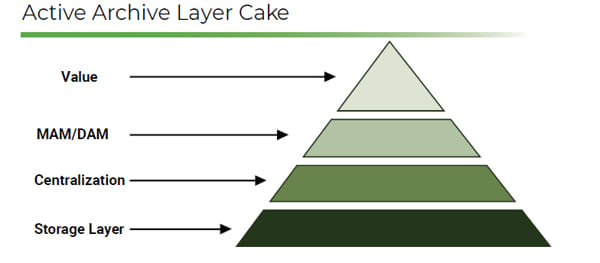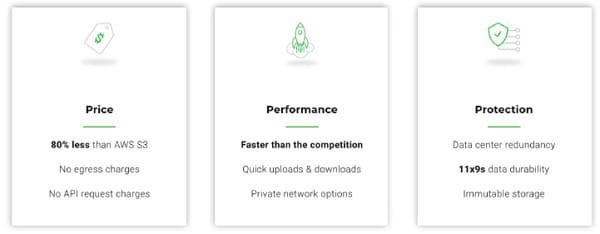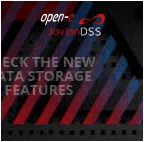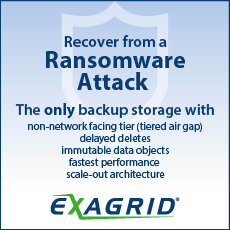Active Archive Strategies for M&E Industry
Everything you need to know to gain instant and affordable access to long-term media storage, monetize archived content, and streamline production workflows.
This is a Press Release edited by StorageNewsletter.com on May 24, 2024 at 2:02 pm By Ben Bonadies, technology writer, specialist in media applications in cloud storage and product marketing manager of M&E for Wasabi Technologies LLC.
By Ben Bonadies, technology writer, specialist in media applications in cloud storage and product marketing manager of M&E for Wasabi Technologies LLC.
Persistent Need for Content Creates Challenges
M&E organizations face some major challenges. The world’s ever-increasing hunger for content not only puts serious pressure on these companies to keep producing, but it’s also causing media libraries and storage costs to skyrocket.
From 8K video to 360° of high-res virtual reality, M&E content can get massive, and organizations need to curb storage sprawl as they continually add to their content libraries. And thanks to over-the-top (OTT) distribution and consumers accustomed to on-demand access, organizations are seeing more value in not only retaining their entire back catalog but also having fast and ready access to them.
Data storage, or more specifically, archiving, is more critical than it’s ever been. Many organizations are finding new ways to monetize their past work, and more editors, artists, and distributors require remote access to vast stores of data to do their daily jobs. Offsite backups are a must, as ransomware attacks in the M&E sector become more frequent.
In this e-guide, we take a closer look at active archiving and why it’s a strategy that can help you future-proof your data archives while keeping all of your content secure and protected.
You’ll learn:
- The pitfalls of traditional archiving
- Strategies and things to avoid to achieve an active archive solution
- Qualities to look for in active archive storage
- Why a single, hot tier for archiving data is the simpler solution compared to multi-tiered systems with limited recall performance and complex billing
- Ways that you can leverage an active archive system to streamline workflows
Traditional Archive Storage: Cheap and Deep Is No Longer Sufficient
“Cheap and deep” used to be the norm for traditional archive storage. It meant burying archival content in inexpensive storage, such as LTO tape. The nice thing was that that glacial archive was durable, secure, and-well, cheap. But it also had some problems.
Tape requires personnel to operate and maintain the storage equipment and the environment needs power, cooling, and lots of space. Plus, every 7 or 8 years you must migrate all of that stored data to new tape versions. That is time consuming and costly. Deep archive data is also hard to search and access if it’s needed later. It could take days to get a piece of content back.
The cloud has helped organizations overcome some of those issues. Long-term archiving solutions for cloud storage, such as Amazon Glacier, can seem to be more cost-effective at first. They don’t require personnel or management. They also are much more scalable and more accessible than tape. But cold storage in the cloud also comes with some hidden (and not-so-hidden) challenges.
While the per-terabyte cost for archival storage is low, legacy hyperscale cloud providers charge you every time you want to access or interact with your data. API calls, data retrieval requests, data egress, each one comes with a service or “transaction” fee. And with petabytes of stored content and data, those fees can add up fast. Beyond the issue of expensive and unpredictable transaction fees is the accessibility problem of traditional and cloud-based cold storage solutions. Cold storage in the cloud is not considered priority so these solutions aren’t performing. They’re inexpensive up-front because of high latency. It can take several hours or more to get content from cold storage. That’s faster than tape, sure, but still not fast enough if you need it now.
Neither traditional tape nor cloud-based cold storage is sufficient if you want to take advantage of opportunities to monetize archived content, enable collaborative workflows across geographically separate locations, or stay competitive in increasingly fierce marketplace.
The ideal active archive solution is balanced and includes:
- Per-terabyte costs that are low enough to justify storing large amounts of content for long periods of time, if not indefinitely
- The ability to access content whenever you need it
- Predictable pricing with no hidden fees
Active Archive Storage: All the Perks without the Problems
An active archive is a place to store all of the data that you may need to access occasionally. It’s too valuable to delete and while you might not need it at the moment, it’s a comfort to know it’s there and accessible when and if you want it-for repurposing, historical record, future reference, or anything else.
Active archiving is the best storage strategy for M&E organizations that want to retain all of their past projects, raw archival footage, outtakes, sound recordings, VFX elements, animations, various language versions of full programs, and more. Active archives increase data access and speed at a substantially lower price point than traditional RAID disk-based solutions (and not much more than tape).
It’s not primary storage, like your highest-performance storage for current projects, but it’s not cold storage either. It falls within that perfect “goldilocks zone” by offering low-cost storage for massive volumes of data that is always readily retrievable.
How active archiving differs from traditional archive storage

The benefits of true active archive storage include:
- Excellent second-tier storage: Highly responsive, active archive solutions help relieve the demand on expensive tier-one storage, enabling you to bring these assets online quickly without breaking the bank.
- Reduced tier-one storage costs: Active archives mean you can archive content sooner, freeing up expensive on-prem tier-one storage capacity since you can access your active archive data quickly.
- Improved collaboration between remote teams: Teamwork across different geographies is easier with an active archive in a single, accessible location- especially important as M&E companies rely more and more on remote and distributed global teams.
- High-speed access with low latency: An active archive based on object storage provides high access speeds and low-latency location awareness with optional replication and caching that make it a solution for online content delivery.
- Near-infinite scalability: An active archive based on object storage can scale to hundreds of billions of objects in a single namespace.
- Flexibility for different needs: Use active archives for long-term archiving or short-term storage with backup capacity that supports protection from ransomware or accidental data loss.
Why Multi-Tiered Solutions Are Not True Active Archives?
Some organizations opt for hybrid multi-tiered storage solutions and assume they have active archiving. But they don’t.
Hybrid multi-tiered active archives are basically a collection of different storage tiers ranging from hot to cold. They might be connected and integrated into a single management dashboard, for instance, but they’re still different buckets of data. No matter how many tiers fall in between hot and cold, or what they call them, from AWS’s Hot > UltraWarm > Cold to Microsoft Azure’s Hot > Cool > Archive tiers, they aren’t true active archive storage.
What they are is active storage AND archive storage, not active archive storage. There’s a big difference.
Hybrid active archives work by tiering data off active on-premises storage and onto colder archive storage once certain criteria are met, usually following a period of inactivity. For hybrid, tiered archives, the archived data will be kept on a secondary storage system, either an offsite “cold” cloud storage or an LTO tape library.
These storage mediums, the primary premise-based storage where the bulk of work is done and the colder storage where the data sits after the content moves off the primary drives, form the 2 spheres of the hybrid active archive. And though this system combines both active and archive storage environments, the 2 do not create a single active archive. In fact, this procedure is identical to traditional archiving, which offers none of the benefits of a true active archive.
The tiered hybrid active archive environment still leaves users with the same problems that come with traditional archives, chief among them accessibility. Archive storage mediums like LTO tape and cold cloud storage are glacially slow. Retrieving data from one might take anywhere from hours to days.
In the case of cold cloud storage services, these retrievals can be exorbitantly expensive. And it’s not just retrieving your data that can be so costly. Tiered cloud storage services charge users when data is moved from one tier to another. Every time data is aged out of one tier to another, the user incurs a charge. This process happens automatically according to policies set up by the organization to make the archiving process more efficient. Remember, this is on top of standing fees for ingest, egress, and any other analytical API operation users might want to perform on their data. It’s because of fees like this that an average of 48% of an organization’s cloud storage bill is allocated to retrieval fees, according to the Wasabi 2023 Global Cloud Storage Index.
In a hybrid active archive, where these systems are deployed as storage tiers, these accessibility roadblocks still exist. A true active archive allows for the free and rapid recall of assets at will, while hybrid architectures involving LTO or cold cloud storage tiers do not provide it.
How active archiving differs from traditional archive storage:
- Scalable so it grows with your organization
- Searchable as a well-organized library so you can find what you’re looking for quickly
- Affordable with low per-terabyte pricing and no punitive fees for data retrieval or API calls
- Accessible through a highly performant, single tier of service
- Reliable and highly available
- Secure to protect vs. data breaches, malicious inside actors, and human error
Streamline Workflows with Active Archive Storage
With true active archiving, you no longer have to decide whether you should hang onto data or discard it. M&E organizations have long known this-especially if they find new ways to use and monetize their content. You can preserve your content in perpetuity. You can reference past material for work on current projects. There is real value in all of that data and that you can store it inexpensively without losing quick accessibility. You can extract that value as you see fit and future-proof your content library.
By storing your archived data in a single, low-cost tier of storage, your organization can begin to break down silos and achieve a more streamlined production workflow where content is always available to anyone at a moment’s notice.
The Active Archive Layer Cake
A good way to think about the ways an active archive can transform your business is by viewing it as a layer cake. Building your active archive starts from a base of storage and selecting the right active archive storage with the criteria mentioned above. We want to call out the importance of a single tier as centralization is key here. Consolidation of storage is what breaks down barriers to innovation. Siloing your data only serves to increase complexity and makes finding what you need when you need it much more difficult. You can centralize your data with software to gain a full scope of data in active archive and on premises, which many Media Asset Managers (MAM) and Digital Asset Managers (DAM) can achieve. From there, your content is indexable and retrieved by key members of your team at will. It is here that your organization can begin extracting value from the active archive layer cake: quickly deliver content for monetization, speed up post-production workflows, reduce administrative complexities associated with the content lifecycle. An active archive can serve as a foundation for a more efficient, profitable, and scalable media organization.

How Wasabi Can Help?
At Wasabi, we believe storage should be simple. There’s no need for complicated pricing and an array of tiers that tie performance to high costs. We’re transforming M&E storage with the most affordable and highest-performing cloud storage solution. Wasabi Hot Cloud Storage allows you to store fast-growing video libraries at low cost without having to compromise on data integrity or security. With it, you get true active archives that offer low-cost pricing with performance. This frees up your expensive on-site storage and reduces the need for pricey on-premises equipment upgrades. You can store everything you need, or even might need someday, confidently and conveniently. It’s inexpensive, fast, and reliable. With no extra access fees.

Here’s how 2 real-life M&E companies realized the value and benefits of an active archive based on Wasabi Hot Cloud Storage
PCEN Media, Inc. is a global entertainment company focused on broadcast production, distribution, and licensing. Its subsidiary, MYTVTOGO, runs 80+ different networks streaming 24/7 through major OTT platforms like iOS, Android, Roku, and Smart TV. Over 100 million viewers in over 150 countries enjoy MYTVTOGO on a monthly basis.
PCEN is using Wasabi to archive videos served up by PCEN’s content management system (CMS) on 44 linear channels. Effectively a content library, the archived videos can be accessed through APIs. Wasabi also stores PCEN’s video-on-demand (VOD) content, grouped into playlists. VODs are simply moved over for playout, as needed.
Wasabi Hot Cloud Storage provides 100% S3-compatible connectivity, and has been validated with hundreds of storage applications, business applications with native cloud storage interfaces, and SDKs. All this compatibility makes Wasabi easy to integrate without business interruption.
“Moving to Wasabi has allowed us to be more efficient in our workflows, especially in how we schedule our linear channels. Not having to use individual playout storage for each of the 44 channels we own makes distribution easier and faster,” said PCEN CEO Don Slaughter.
With Wasabi active archive, PCEN Media was able to:
- Eliminate costly egress and API request fees
- Better forecast storage needs and budget
- Improve workflow efficiency
- Protect digital content from ransomware
Case study: PCEN Media Switches to More Responsive, Affordable, and Efficient Active Archiving.
7 Wonders Cinema LLC became successful by creating video content that tells human oriented stories. As the company expanded, it maxed out every drive it had as well as several Google Drive accounts. Moving to a higher tier of service with Google or trying AWS would be prohibitively expensive because of the company’s need to occasionally access stored footage.
With Wasabi Hot Cloud Storage, 7 Wonders Cinema gets the best of both worlds: low cost, long-term cloud storage and the ability to instantly access files whenever they need them. The company is highly satisfied with Wasabi’s price and performance, and they are also pleased with the high level of customer care and service. They appreciate being able to ask questions, discuss matters with Wasabi staff, and get swift resolution and responses when they have an issue.
“The low price point is what originally drew us in, but the customer service is what is convincing us to stay,” says co-founder Michael Ayjian.
With Wasabi active archive, 7 Wonders Cinema could:
- Get fast access to stored footage anytime
- Eliminate need for additional HDDs for long-term storage
- Retain more data for longer periods of time
Case study: 7 Wonders Cinema Turns to Wasabi for Cost-effective Active Archiving
Conclusion:
As M&E organizations grapple with the challenges of retaining, managing, and utilizing their ever-growing volumes of data, it’s critical to find the right archive storage. Increasing demands for content are driving media companies to active archive solutions for low-cost, scalable storage that delivers fast and reliable access to data right when it’s needed.
Active archiving is changing the way M&E organizations consider their content. It allows them to seek new ways to monetize their content and streamline workflows while saving money. It balances accessibility with affordability and overcomes the challenges of traditional tape- and disk-based storage and cloud cold storage. With low pricing, performance, and data protection features, Wasabi Hot Cloud Storage is the smart choice for M&E organizations that want to reap the benefits of active archiving.














 Subscribe to our free daily newsletter
Subscribe to our free daily newsletter

